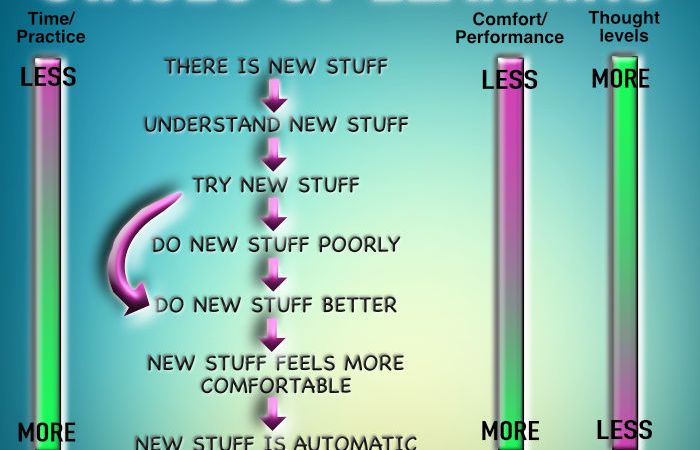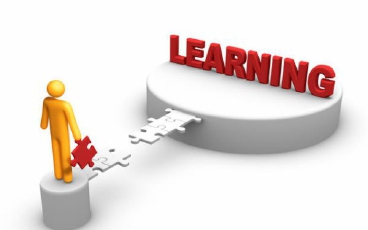A lot of us want to leave the lesson after failing to hit the ball better. But we stick with it. We know that whilst the result might not be better instantly, it requires repetition until the new movement/concept/skill becomes ingrained so you do it without thought – this is called practice.
Practice is learning and it takes time. We may change one thing, but it will have a knock on effect to lots of other areas. We need to get all the cogs turning together before the machine fully functions. This means that you need to understand the art of HOW to learn, equally as much as the WHAT.
Famous Words
Tiger Woods once said (regarding his swing changes):
"First I understand what I need to do, then it looks better, then it feels better, then it performs better in practice, then on the course, then finally in a tournament."
This is a good representation of the stages of learning. Sports psychologists call them cognitive, associative, autonomous etc and I have also seen terms such as conscious competence, subconscious competence etc. But these terms are less important than what they mean.
 In a lesson, we learn what it is we should do – for example, a grip change. We learn and understand that we should see 2 and a half knuckles on the left hand, and 2 knuckles on the right hand (perhaps).
In a lesson, we learn what it is we should do – for example, a grip change. We learn and understand that we should see 2 and a half knuckles on the left hand, and 2 knuckles on the right hand (perhaps).
Next, we try the grip but it feels very new and strange. We probably top a lot of shots whilst we our body is getting accustomed to it. We have success, but it is low – our body is still figuring it out. Occasionally, we can bypass this stage, but this should not be your expectation.
The ‘do new stuff better’ stage usually occurs within an hour or less. Repeating it makes it feel a little better, but our performance can still be erratic.
The ‘new stuff feels more comfortable’ stage usually takes at least a day, if not a week (depending on how much the person practices it).
The ‘new stuff is automatic’ stage can take months in some cases. I have also heard quotes such as it taking 3,000 repetitions for it to become natural, although I find it varies wildly depending upon what you are working on.
They say it takes 10,000 hours to truly master something. This statement has been taken out of context and is largely overblown hype. You certainly can get good at something with much less practice, and simply doing 10,000 hours doesn’t guarantee you will master it.
Stay Safe
It is important to take time to get comfortable with something in a safe environment, such as a range. But make sure to take steps in improving transference of that skill to the course.
Whilst a better technique usually brings about better results immediately, it really depends. If the technique is very new, or highly uncomfortable, then it can take a little longer and we must be patient. Also, if there were a whole host of compensatory issues, it may take a while for them all to unfold.
On the other hand, if the old technique was very poor, a new position may offer instant gratification and become more comfortable faster – this is where we can skip the ‘Do new stuff poorly’ stage.
Expect Reality
If we look at the above model (model of learning) and have that as our expectation, we can become more competent learners.
Learning falls apart when people think they are going to go to the last stage too quickly. I often see this in a lesson where someone comes back the next day doing the old mistakes, even though they could do the new move perfectly yesterday. Obviously they believe that working on something for one hour should be enough to ingrain it – clearly not.
Practice Makes Perfect
The worst mistake I see is when someone gets to ‘do stuff poorly’ and then quits because performance is poor.
Patience is a virtue here, no one has ever learned anything the first time they tried it. You didn’t learn to walk the first time you tried – but luckily you continued to practice.
Be patient – it took a lot of repetitions to learn to walk effectively. Muscles had to strengthen; ligaments and tendons too. You wobbled at first, fell down a lot. But look at you now. You can even do it without thinking.
The prescription here is more practice, more repetitions and less result orientation. Take away the ball and make more practice swings until it feels comfortable and you are thinking about it less. Top pro’s sometimes only hit 20 balls in an hour, using mirrors, video and other feedback devices to get it in the practice swing first. Closing your eyes can give you heightened body awareness, making slow motion swings can also help you learn the move in more detail before you gradually increase the speed.
A Side Note
The ‘Stages of Learning’ model is only one model of learning. There are other models which can be more implicit learning which bypass the consciously identifying and understanding stages.
I like to use a lot of task led lessons to change techniques. Through task led changes, the player does not necessarily have to understand consciously how to do it, leading to a more natural and less analytical approach to learning. However, some people need a conscious ‘nudge’, to which I will give it to them if deemed appropriate.
There are also examples of cases where changes can be automatically more comfortable and even become quickly automatic. For example, if you relate the skill to be learned to something already learned, we can greatly speed up learning.
Cliff Notes
So stay patient, accept that learning take time in most cases, and practice with an end goal in mind. Eventually, anything that feels strange will become natural if repeated enough. Just make sure to see your professional golf teacher so that you are working on learning the CORRECT things. All professional golfers understand this process, and it is why they became good at the sport.
To learn more about what, when and how to learn this game more effectively, read more about the book “The Practice Manual”.

